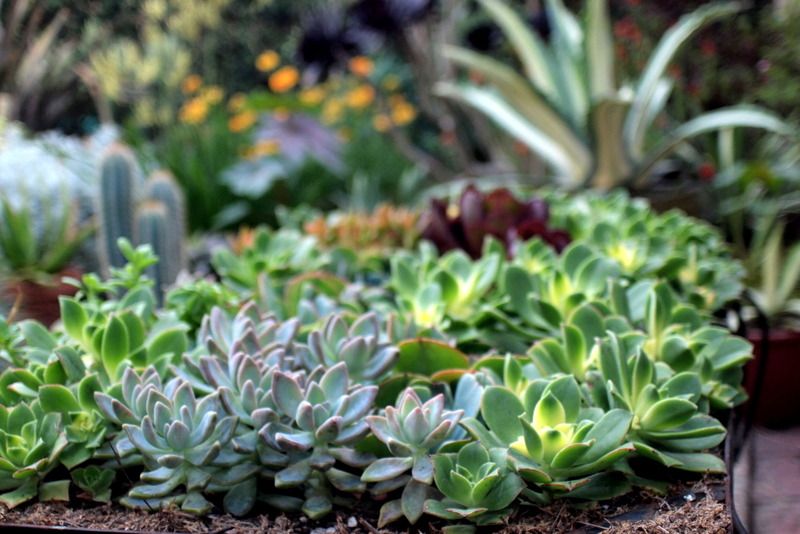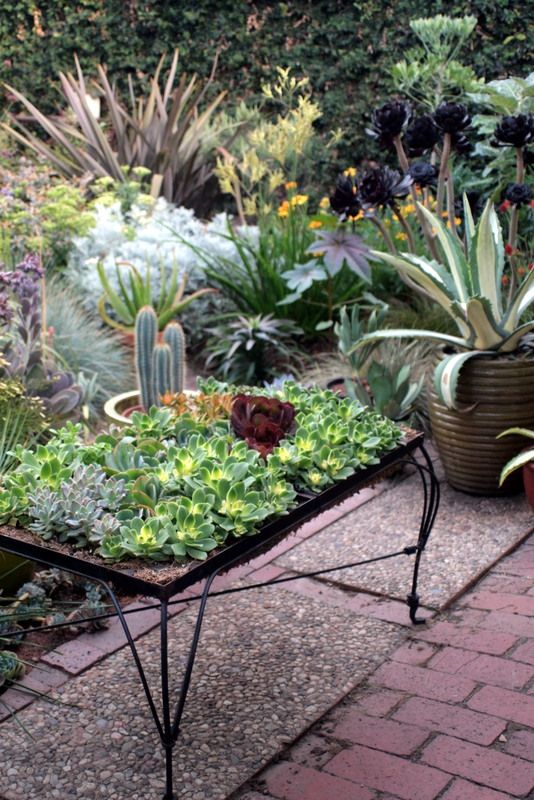I had to laugh when I saw Reuben’s latest project on this post, planting the frame to an old television monitor, which I think is incredibly classy and wish he’d sell to me. (Look at those aeonium knobs!) I completely understand the impulse. Where we differ is, I suspect Reuben starts with the concept first. Most of my projects start with a desperate need to thin out overcrowded plantings.

The mind and eye wander into the garage, the garden shed, rummaging for something, anything to contain the prodigious amount of offsets these plants produce. I don’t want every pot I own filled with thinnings of Aeonium ‘Kiwi.’ Something with a broad, shallow surface is needed to absorb their numbers — like the base to this old wrought iron table. At first I resisted, because I really wanted to make a functional table of it again, with a usable surface, but the tyranny of the procreating abilities of these plants won the argument. At least I haven’t started planting old boots…yet.

The table was planted in early summer and was kept in light shade until strong roots formed. Prior to planting, a lot of these thinnings had been dumped into buckets, destined for the compost pile, which had the beneficial effect of drying out the ends to form a callus. Callusing is often recommended and probably the safest practice to prevent the stem from rotting away. But when the planting frenzy started, I also grabbed fresh cuttings from the garden, and these did fine as well.

In the design equivalent of convergent evolution, the materials and method used were pretty much identical to what Reuben details in his post; stretching and affixing wire mesh hardware cloth, lining it with moss, filling in with potting soil. I moved the table into full sun just yesterday while we’re being graced with an amazing stretch of mild weather in the mid-70s. The sun will bring out the strongest coloring, but I’ll move it back into light shade when high temperatures return. Aeoniums, dark red and ‘Kiwi,’ Echeveria glauca, Sedum nussbaumerianum, Graptopetalum paraguayense. The planting depth is thinnest at the exposed table edges, which should be covered in another couple weeks as the plants enlarge and mature. The mossed screen might be 4 inches at its greatest depth.
Following Reuben’s example, I’m going to try starting with the concept first. Now I’m on the lookout for old tv monitors to accommodate an elaborate staging of the visual pun “Watching grass grow.” But I doubt I’ll have the discipline to see it through and use something as pedestrian as turf. I’d much rather plant it with a bright green screen of sedum. Or maybe I could plant the Indian Head Test Pattern in succulents? (I’m joking…I think.) But the possibilities rival the number of channels on cable. Thanks for pointing the way, Reuben.

The table is gorgeous, Denise! Talk about classy …
Reuben, tables have been done before, but not tv’s! Hanging on a fence, watching the nature channel on tv — the puns just go on and on. It’s a goldmine of ideas!
Well that is just splendid Denise ! However, where does one set ones wine glass ?
Oh if only I had such problems of multiplying succulents…
Love the table! I’ve got an old bike with basket planters. Sounds worse than it is – the rust makes it cool.
Kathy, you’ve identified the design flaw. This will probably be a temporary arrangement.
Lisa, I know it probably sounds too good to be true, but some get quite sprawly. Good luck with the bike!
I really enjoy your blog. I love the great photos and interesting photos you post. That succulent T.V. is just too clever. How cool!
Susan
Hey, I’ve got boots planted with sedums and I love their quirkiness. I can’t imagine having so many aeoniums I have to throw them in the compost. How blissfully wonderful. Beautiful table.